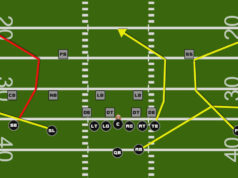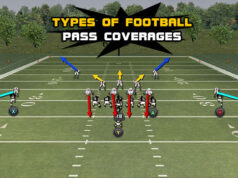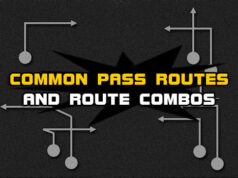In this X’s and O’s Football Football Strategies, we want to focus in on executing the offense on the field. To do so, we divide the field into four critical zones: yellow, green, red, and gold.
Yellow Zone
The yellow zone is what we call backed up. This zone is from your 10 yard line to the goal line. You must have room, especially if you end up punting the football.
Additionally, it is very unlikely that you will score from this position. But if you are not careful you can give your opponent an easy opportunity to score.
The critical point in the yellow zone is to be smart and strategic and to use formations and personnel sets that are strong against anything the defense will throw at you. In the yellow zone, we like to use our Big formations.
The Big and Jumbo formations are the basic structure for our offense in the yellow zone.
After choosing the structure of the offense for the yellow zone situation, we need to decide what we are going to do. Sometimes the game situation and momentum will decide that, but, in general, we must decide if we are trying to pull off big plays from this area or if we are simply trying to protect the situation we are in while attempting to get into a more favorable situation. When the offense is backed up in the yellow zone the defense tends to bring a pressure scheme to keep the offense trapped inside the zone.
Although scoring is very difficult from this position on the field, it is not impossible. But, to score, you will need at least one explosive play. Our play calling in this zone does not deviate from the base calls in the game plan. The formation structure may change but the play calls are similar.
We change to a safer formation because ball security is the number one priority in the yellow zone. The power run and play action are two key calls for us in this zone. While ball security is a priority this is not a time to play scared. It is, however, a time to play smart.
Green Zone
The green zone is the area from our own 10 yard line all the way to the opponent’s 25 yard line. We like to refer to this zone as the free-willy or scheme zone. Many of the pass concepts and schemes should be run in this area of the field. The task is to remain balanced. By balance, however, we are not referring to run and pass ratios, but rather to run and pass efficiency and success.
It is very important that you develop a scheme and know it like the back of your hand. Once you get in the green zone, let it rip. We recommend practicing your scheme on a daily basis. Get your reps in. By getting reps in with your offensive scheme, you will have an offense that is quick to call in the huddle and easy to execute on the field, thus making it difficult for the opponent to defend.
Red Zone
Defenses tighten up when they have shorter areas to defend. The red zone is that short area inside the 20 yard line where defenses make it very difficult to get into the end zone. If the defense holds the offense to a field goal, then that is a victory for them. Field goals can win football games, but we do not want to rely on field goals to get us the victory. We need to have a red zone plan.
Gold Zone
The final critical zone is the gold zone. This is from the 5 yard line and in (or short yardage situations in other zones). While balance is the focal point in the other zones we abandon that when we get in the gold zone. The gold zone is about who wants it more. It is about our best guys against their best guys. In this area the ground game must come through for us. This will be the focus.
Short yardage is a bit different than what we have discussed thus far in reference to the gold zone. The biggest difference is the amount of field the defense has to cover. When we talk about short yardage gold zone situations what we have is a crossing or mixing of zones. In short yardage situations the gold zone can be a part of the yellow, green, and red zones.
The emphasis is the same—we need to pick up 1–2 yards. But in short yardage situations we may use any formation we wish. We may opt to go with a four-wide-receiver set rather than the big goal line formation that we would use on the 1 yard line.








